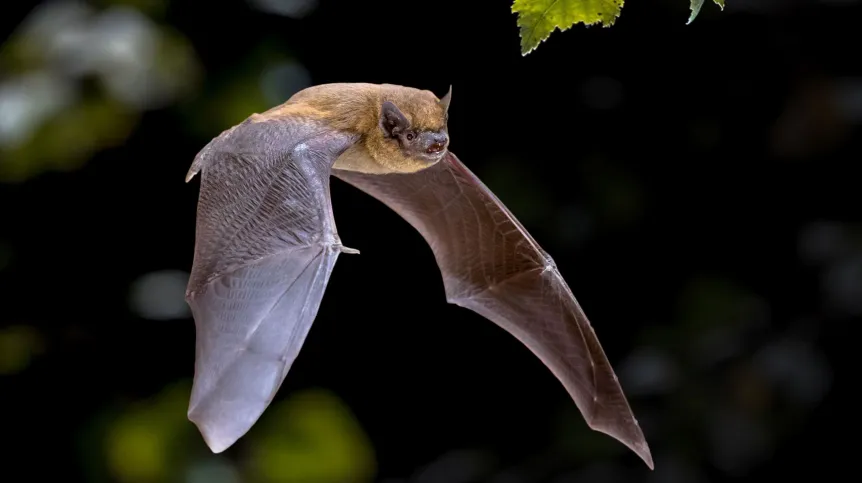
Some living organisms can be used for biomonitoring, i.e. monitoring the state of the environment and the level of pollutants. Scientists from the Jagiellonian University have proven that bats are ideal bioindicators when it comes to trace metal contamination.
The accelerated biodiversity decline is currently one of the biggest global problems. A serious threat to biodiversity and population sizes are trace metals present in excess in the environment, originating from anthropogenic sources, mainly metallurgy, mining, road traffic and the paint industry. Due to their tendency to persist in the environment for a long time, accumulate and become toxic, monitoring and assessing the impact of trace metals on ecosystems is essential.
The idea of using animals, plants and other organisms as indicators of environmental pollution was conceived several decades ago. Species that are suitable for this, however, must meet certain conditions. Bats have a number of traits that make them ideal candidates for such applications.
'The most important thing is that bats are at the top of the food chain; they are predators that virtually no other animals eat. Contaminants ingested with food (in the case of European bats, mainly insects) have a chance to accumulate in their bodies for years. And we know from previous research that some toxic substances accumulate in the food chain,’ says Professor Ryszard Laskowski from the Institute of Environmental Sciences of the Jagiellonian University, head of the Terrestrial Ecosystems and Ecotoxicology Group.
He adds that bats can live over a dozen years, which means that harmful substances accumulate in their tissues for a really long time.
The professor and doctoral candidate Olha Timofieieva combined their key scientific interests, i.e. ecotoxicology and bat biology research. The result is a publication in Science of the Total Environment.
'As apex predators, these animals eat a lot of food. The concentration of toxic substances in their tissues may increase over time unless these substances are excreted from the body. A classic example are pesticides, which dissolve easily in fats but are difficult to dissolve in water, so they are not excreted in urine and accumulate in fatty tissue. When times of starvation come, fat is consumed and toxins are released into the bloodstream. Because they have accumulated for a long time, their levels are thousands or even millions of times higher than environmental concentrations, which can make them highly toxic to the body', says the expert from the Jagiellonian University.
Another aspect that distinguishes bats is that, unlike birds, they do not have feathers or hair on their wings. Their flight membrane is not protected by anything, but it is strongly supplied with blood. 'This is a potential additional route of contamination for these animals - through the body surface. In other species, a large part of the toxins is deposited on feathers and fur, which protects against harmful compounds entering the organisms. There is no such protection in bats,’ Dr. Laskowski says.
He adds that in the case of metals, this is not that important, but it is extremely important in the case of contamination with insecticides (substances used to combat pests in crops), which are commonly sprayed by farmers. He adds that for several years, in order to protect pollinators against these agents, there has been a requirement to spray them only in the evening, when insects no longer feed on the flowers. Meanwhile, that is when bats, nocturnal animals, begin to go out to feed. 'This was another aspect in favour of studying them,’ he says.
Since all bats are extremely useful and protected animals, killing them for environmental monitoring or any other research purposes is not an option. But it is possible to take small samples of their fur or flight membrane without compromising their health, because they grow back. 'That was the goal in our work was: to see whether the concentrations of trace metals that we find in the fur and flight membrane, and which are easy to measure, accurately reflect the concentrations in internal tissues,’ Laskowski says.
All animals used in the experiment came from the Bat Rehabilitation Centre in Kharkov, Ukraine. Sick, disabled animals, etc. are brought to the centre and then released after rehabilitation. 'Those that could not be saved and died were kept for scientific purposes, and we used them,’ says the scientist.
It turns out that the concentrations in external tissues actually well reflect what is happening in the internal tissues that are key to the functioning of the body, mainly the kidneys and liver, which tend to accumulate metals and other harmful substances. 'And when these substances accumulate for years, a toxic effect can eventually occur. Therefore, we wanted to assess not only the environmental pollution itself, but also the exposure of animals living in a given ecosystem to these pollutants. It turned out, for example, that although soil tests near Mariupol did not show high trace metals contamination, their concentration in bat tissues was significantly increased,’ Laskowski says.
The next stage of his team's research is conducted in Poland, near Olkusz. The preliminary results are 'optimistic because - despite significant environmental contamination - bats regulate the concentration of trace metals inside their bodies quite well'. This is evidenced by the fact that the content of these elements in internal tissues was not very high, but in faeces it was huge. 'It is clear that bats are exposed to these contaminants that pass through their digestive tract. So far, they are being excreted effectively, which is good news, but we don't know at what cost. Remember that nothing is free in biology and physiology. We will try to answer what this cost is in subsequent studies,’ the expert says. Researchers suspect that this may be to the detriment of the immune system, reproductive system or hunting performance.
Professor Laskowski adds: ’We found some amounts of DDT (dichlorodiphenyltrichloroethane - ed. PAP) in them, which is interesting because the use of this substance has been banned virtually all over the world since the 1970s. It remains a mystery whether this DDT was used somewhere in violation of the ban or maybe, due to the fact that it is a very persistent substance, it comes from old sprayings still present in the environment, because this is entirely possible.’
The expert concludes that the study provides innovative data on the accumulation of trace metals in bats. 'We found that animals living in an industrialized area accumulated more cadmium, lead and zinc in their external tissues than animals from rural areas. In one of the studied species, we also showed a significant correlation between the concentration of metals in external tissues and in internal organs. This shows that the threat to bats from trace metal contamination may be significant and that the degree of threat to individual populations can be monitored by intravital sampling (samples obtaining them from living individuals - ed. PAP) of external tissues,’ he says. (PAP)
Katarzyna Czechowicz
kap/ bar/ kap/
tr. RL













